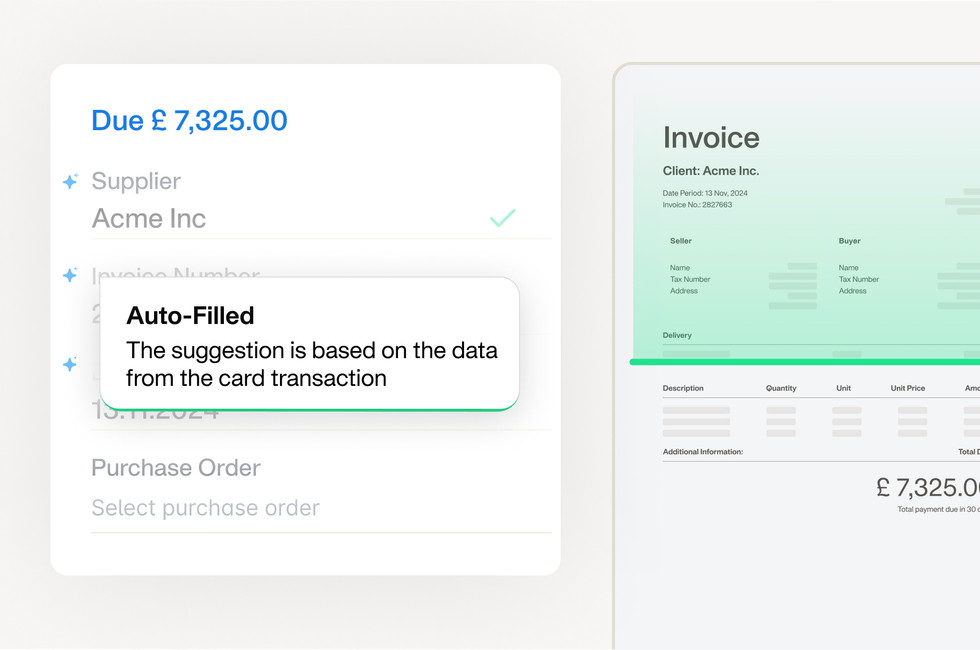
How automated expense approval emails speed up the expensing process



Payhawk customers can now streamline approval workflows and speed up employee reimbursements more efficiently than ever. Our four brand-new expense approval emails mean that customers can automate emails to notify employees when and why expenses are rejected or returned in real-time, prompting them to make timely amends and keeping workflows super efficient.
By submitting this form, you agree to receive emails about our products and services per our Privacy Policy.
How expense approval emails improve the expensing process
Picture this, you’ve got tonnes of jobs to do to close your month, and you're already behind schedule. One of the biggest challenges? Missing and incorrect expense information, where your non-finance colleagues have submitted an expense and it’s been rejected based on a lack of details. This means that now on top of everything else, you need to chase them for expense reports that they think they’ve already completed. It’s not a good start to the month-end.
If, like in the above scenario, you don’t use automated expense approval reminders, you’re going to create unnecessary delays when it comes to approving or rejecting expense submissions. These delays mean employees don’t get expense approvals quickly and together you create an operational bottleneck.
And as your organisation scales, things only get messier. The number of employees you need to chase increases, and the needs of the business become more complex.
That’s where the new feature ‘expense approval emails’ comes in. We understand that a speedy result on returned expenses is important for businesses, so we made it a key objective to create a solution that would make this faster and more effective. The result?
The new release reduces the time employees spend resubmitting returned expenses by 70%.
Save time with innovative, automated expense management
Improving employee expense tracking
If you find tracking the progress of expense approvals challenging, you’re not alone. Lack of visibility is a problem many of our customers face. And there’s no place for clouded visibility when it comes to business expense management .
Lack of visibility over corporate expenses casts uncertainty across the whole business. For example, how much cash flow and runway do you have left? And are you definitely making more than you’re spending? There’s just no place for clouded visibility when it comes to business expense management.
All of the above, plus delays in the expense approval process mean you can’t track pending expenses accurately, and employee expense reimbursement becomes burdensome due to delays in re-submitting expense approvals. This means the entire expense tracking process becomes long, drawn out, and tedious for all involved. So far, so bad.
But it’s a different (much better story) with our expense approval emails. Employees are kept notified in real time when expenses are rejected, incomplete, or unsubmitted. And both your Payhawk admins and your employees will be automatically notified when one of these issues arises.
These expense claim emails give your approvers full visibility over the entire expense process, so they can quickly spot where there are wrinkles. And employees are notified when there’s a problem so they can deal with it as soon as possible, rather than being bombarded with requests all at the end of the month.
How to write an effective expense approval email
Worried about creating reams of approval and rejection emails? No need. We’ve already crafted them for you and all you need to do is select the parts that you want to use so it’s fully customised for your business. Here’s a quick rundown of what they usually contain and why.
Typically the emails will always contain the following four elements:
- The subject line
- The details of the expense
- An explanation of the next steps
- And a clear call-to-action
Each of these elements plays a part in the custom notification process, from initially capturing employee attention and clearly communicating the reason for the email to detailing the action they need to take.
1. A clear and concise subject line
The subject line should clearly communicate what the email is for to ensure it’s not missed or deleted accidentally. Data from Zippia suggests personalisation in the subject line can increase email open rates by up to 50%. That’s why we use the employee’s name and the reason for the email right there in the subject line.
Example: ‘Pavel, your expense has been rejected’ A direct subject line like this with a touch of personalisation can encourage the recipient to open the email and act quickly, therefore resolving any expense approval delays.
2. All the necessary information about the expense
We use ‘bold’ text to highlight the most important points of the email. Making sure the section where the employee needs to act fast to re-submit an expense is highlighted.
We get straight to the point, and explain why they’re receiving the email. It could be they ategorised their expense incorrectly, or the expense was outside of the expense policies defined by the company, whatever the reason, we let them know fast.
3. Clear next steps
The email clearly explains why you rejected their expense, i.e. incorrect category, it violates your expense policy, or there’s missing information. We keep this clear and simple so that just by scanning the email, the employees know what they need to do and why they need to do it.
4. A short and simple call-to-action
Although we’ve explained the next steps in the body of the email, we also make the next step glaringly obvious by including a call-to-action button with the words of the action to complete. I.e. ‘re-submit expense’ or ‘submit expense now’.
These emails are built to help guide the employee through the problem and what they need to do to rectify it and all without human interference. These emails can be automatically pushed out whenever an action is triggered, for example, if the approver denies the expense.
The introduction of automation in this process makes the approval process more efficient, with no more manually chasing employees to submit expenses and better visibility for your approvers and finance team.
Payhawk’s four brand-new email notifications help streamline your expense reimbursements. Reducing the time it takes employees to resubmit rejected expenses by 70%.
Five effective expense approval email templates
Streamline your expense approval workflows and process timely reimbursements with five of our email templates. By leveraging (and customising) the ready-made templates you can reduce the need to track expense approvals and boost spend control and visibility.
Create clear, concise emails with our templates and help reduce employee time to resubmit returned expenses by 70%.
Here are just four examples of the many use cases you can target with Payhawk auto-emails.
Example 1: Expense submission reminders
Notify employees and remind them to submit their expenses for approval with an ‘expenses in waiting’ email that automatically gets sent to employees once a week.
These notifications act as gentle but necessary reminders, nudging employees to take action promptly.

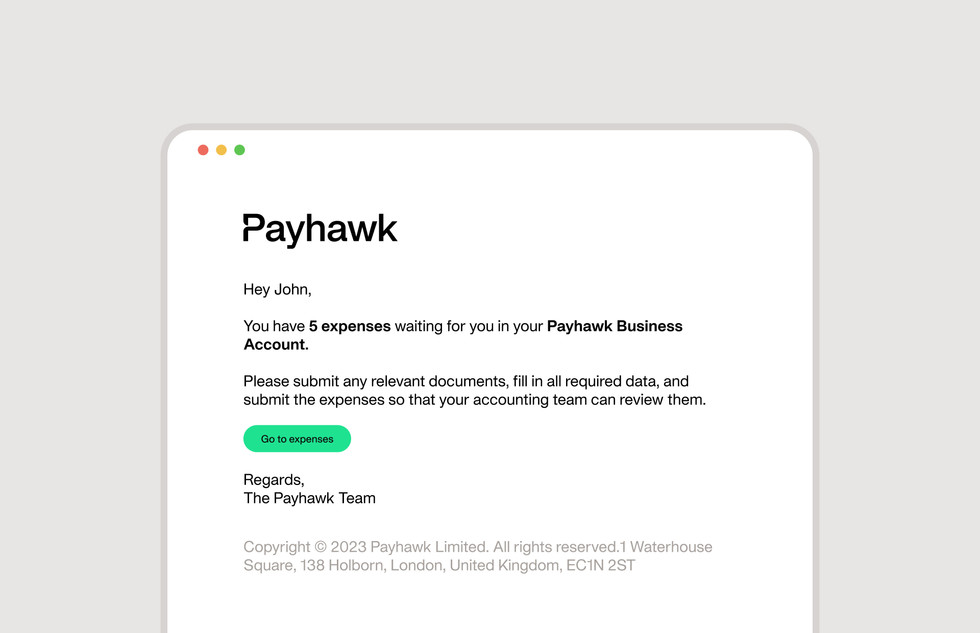
Example 2: Rejected expense submission email
If the expense submission sits outside of your spend policy, you need an efficient way to reject the expense while explaining why it's been rejected so you can help the employee understand how to expense correctly going forward.
If the spending is outside of policy, you can always provide a link to your spending policy so they know how to submit their expense and categorise them correctly going forward.
Your rejected expense submission email notifications can be sent out in real time.

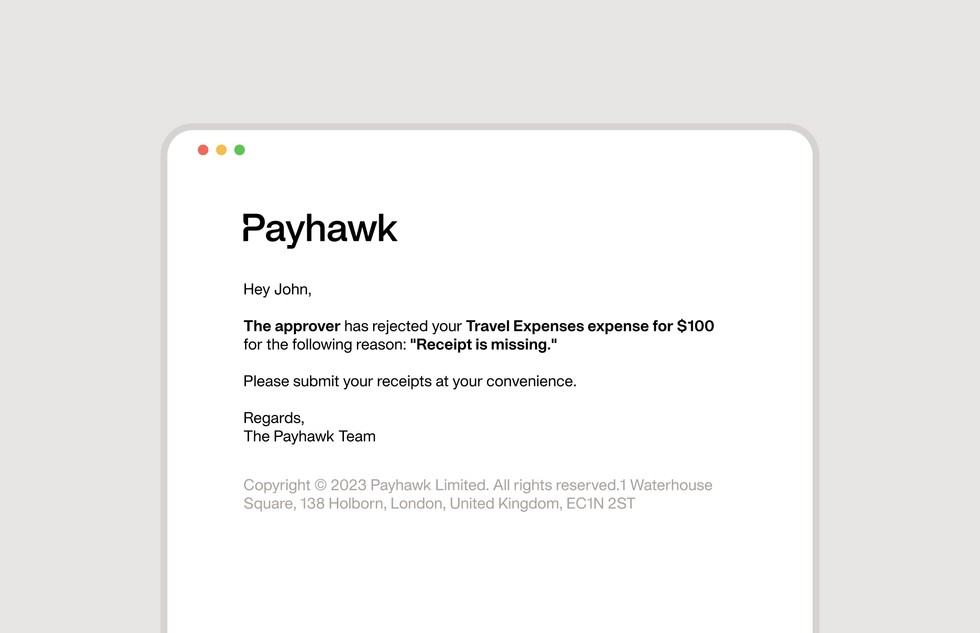
Example 3: Returned expenses email
There are many reasons why expense submissions must be returned to the employee to resubmit. Reasons can include:
- Incorrect supplier information
- Miscategorised expenses
- Missing fields
As soon as an expense approval comes in that doesn't meet your criteria, the email is instantly sent out in real time.Usually, the expenses are returned when the approver wants to know more about your corporate spend. For example, if they want to see what subscription you purchased within your department, and how you will use it.
Example 4: Weekly admin ‘expenses in waiting’ overview
Automating email notifications isn't just to streamline the expense approval process for employees; they can benefit the approvers, too.
Not only are approvers able to automate the entire process of chasing receipts, but they can also set up weekly overview emails to go over the statistics, and follow-up with busy employees. This helps them gain visibility over all expense report requests, and track everything in one place.
You can set these overview email notifications to generate weekly, landing in the approvers’ inbox.
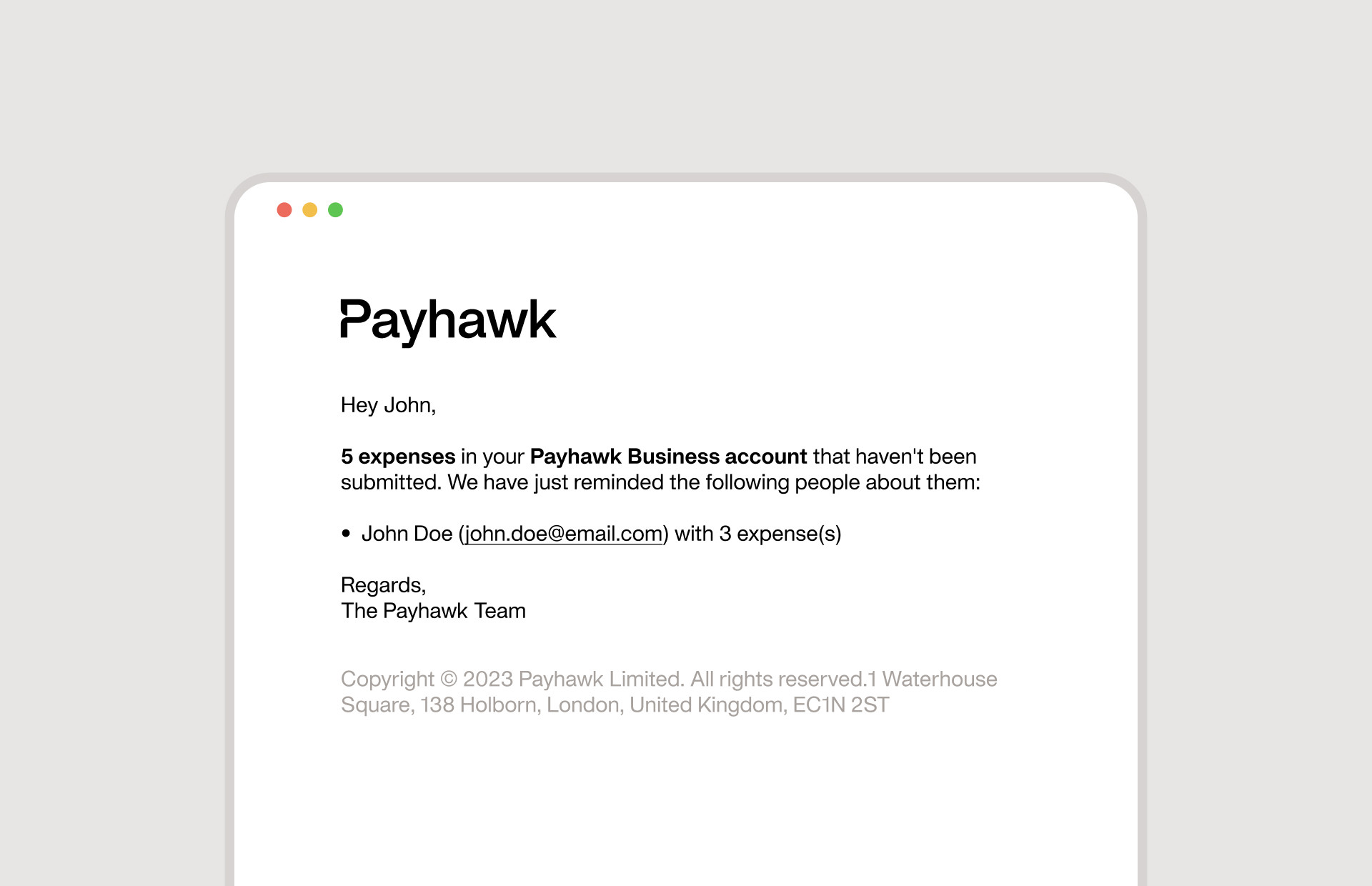

Example 5: Travel expense reimbursement and other pending invoices
At Payhawk, we have a direct integration to TravelPerk meaning you can enjoy full business travel arranging and real-time visibility over business travel spend across your organisation.
You can easily track business travel expenses, and create travel reimbursement request emails to capture all the travel cost information you need for quicker and easier reimbursement of travel expenses.
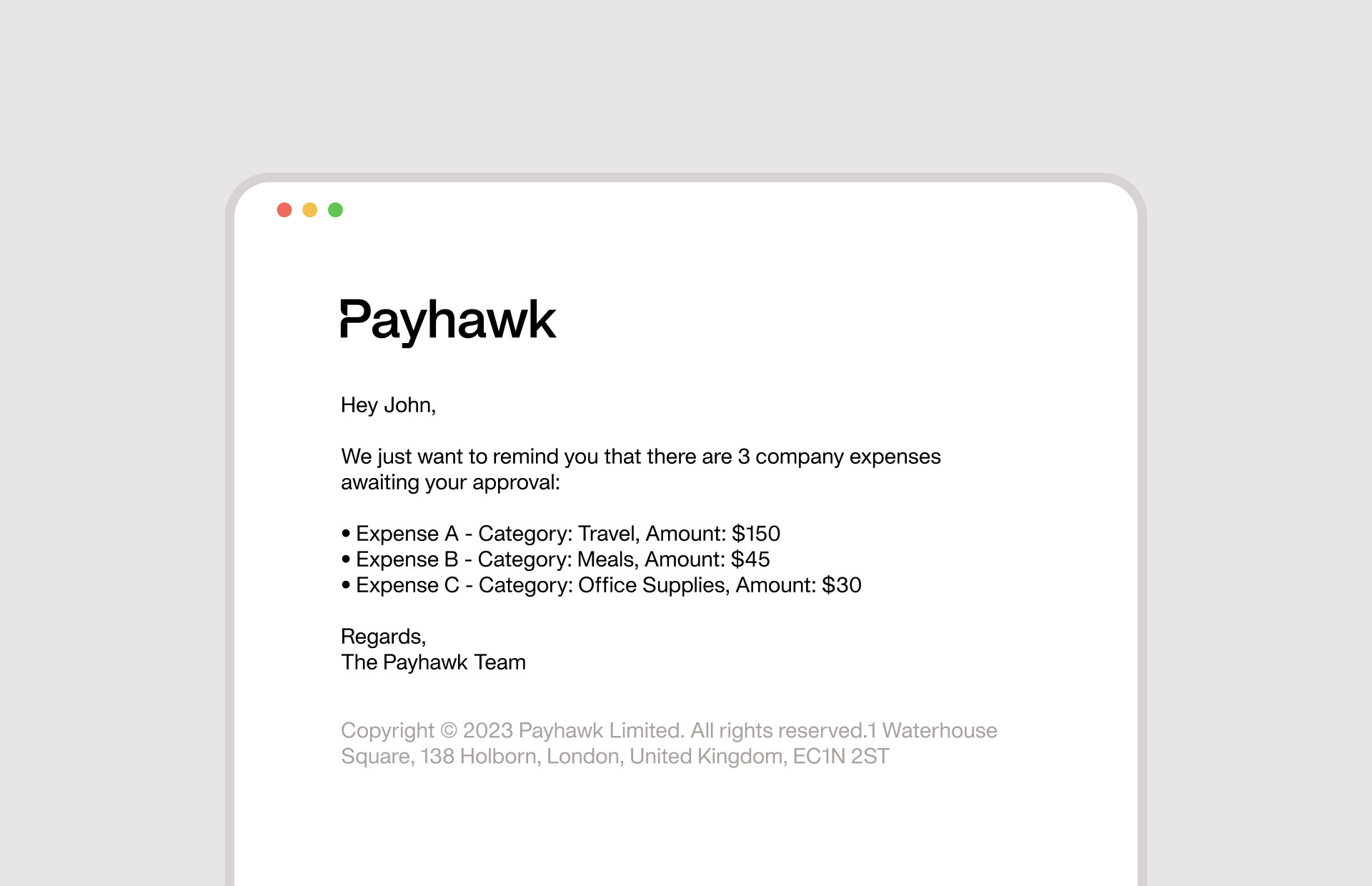

Automating expense approval workflows with Payhawk
You’re busy, which means automation can become your best friend. Now you can automate spend data collection, receipt chasing — and notifications on rejected expenses for resubmission.
As a finance leader, you know that employees will sometimes incorrectly categorise expenses, or miss important information. But now, you don’t have to get involved with manual email chains and back and forth as you chase for info..
By automating your expense approval workflows with Payhawk, you can:
- Enjoy real-time communication: Real-time notifications for returned and rejected expenses mean employees are always informed about the status of their submissions. The notifications enable them to take prompt action and reduce expense approval delays.
- Save employees’ time with our email notifications: When employees spend money, they just want to scan the receipt in a mobile app, upload it, get approval and receive reimbursement. Payhawk email notifications fast-track this process and save employee time on resubmission by 70%.
- Remind staff of expenses in ‘waiting’ status: Our weekly employee reminders for business expenses in the "waiting" status mean that employees don’t forget to submit their pending expenses, promoting timely employee reimbursements.
- Achieve enhanced admin overview: Improving visibility is critical for Admins to receive a comprehensive overview of employees with expenses in the "Waiting" status every Monday, simplifying follow-ups and improving visibility.
Want the power of automation behind your expense processes? Book a demo with one of our experts to share your company's unique challenges and see our email notifications in action. Book a demo today.
Trish Toovey works across the UK and US markets to craft content at Payhawk. Covering anything from ad copy to video scripting, Trish leans on a super varied background in copy and content creation for the finance, fashion, and travel industries.
Related Articles

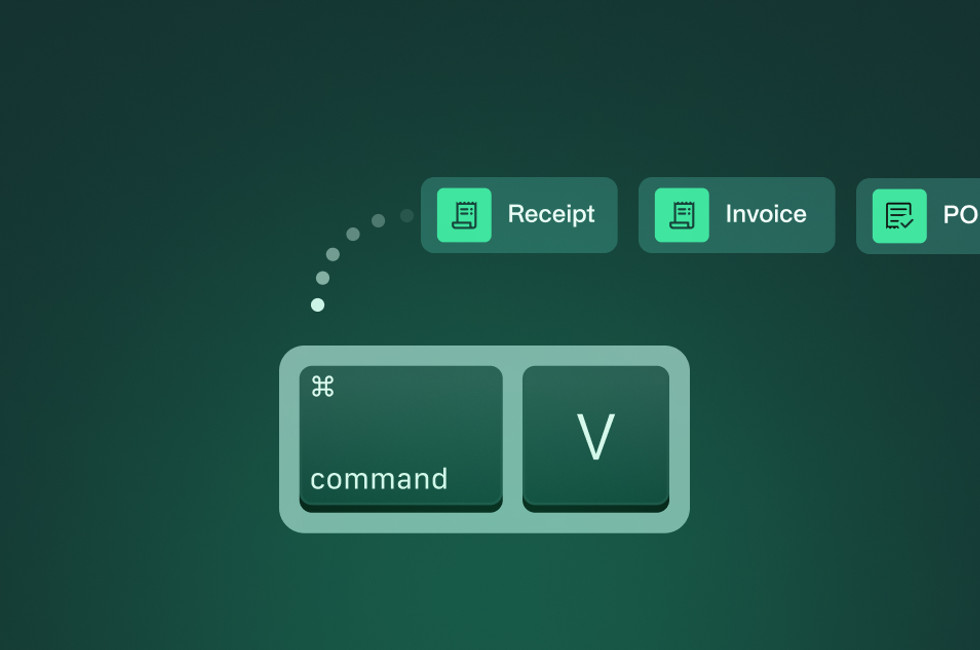
Speed up expense management with clipboard features and more
